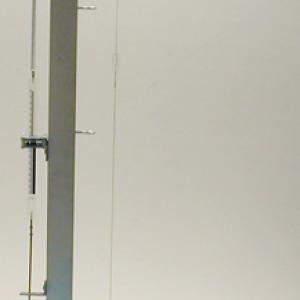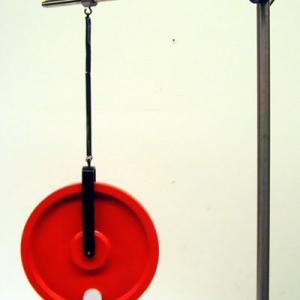College of Liberal Arts & Sciences
3A60.40 - Driven Resonance - Pasco Oscillator and Rotating Mass on a Spring
Practice will be needed for the Pasco machine. Resonance for the Pasco machine should be around 1.79 to 1.81 HZ. There are accessories available for this unit that allow you to do damped, critically damped, and overdamped demo examples. There is also a variable gap horseshoe magnet that can be attached to one of the Pasco machines to provide varying amounts of damping.
The rotating mass has masses that can be added which will allow it to rotate out of balance. Hang the rotating mass by its spring on a very sturdy rod and crossrbar. Spin the mass and as it slows down in will eventually send the system into resonance as evidenced by a very large oscillation.
- Yajun Wei, "An Entertaining Resonance Experiment with Just Two Spring Scales", TPT, Vol. 62, #2, Feb. 2024, p. 90.
- William Dittrich, Leonid Minkin, and Alexander S. Shapovalov, "Mechanical Parametric Oscillations and Waves", TPT, Vol. 51, #3, Mar. 2013, p. 163.
- Ken Taylor, "Resonance Effects in Magnetically Driven Mass‐Spring Oscillations", TPT, Vol. 49, #1, Jan. 2011, p. 49.
- Michael C. LoPresto and Paul R. Holody, "Drag Forces, Authors' Response", TPT, Vol. 41, #5, May 2003, p. 262.
- A. John Mallinckrodt, "Drag Forces", TPT, Vol. 41, #5, May. 2003, p. 261.
- Michael C. LoPresto and Paul R. Holody, "Measuring the Damping Constant for Underdamped Harmonic Motion", TPT, Vol. 40, #1, Jan. 2003, p. 22.
- Chris A. Gaffney and David Kagan, "Beats in an Oscillator Near Resonance", TPT, Vol. 40, #7, Oct. 2002, p. 405.
- Walter Roy Mellen, "Spring String Swing Thing", TPT, Vol. 32, #2, Feb. 1994, p. 122.
- Fabrizio Pinto, "Parametric Resonance: An Introductory Experiment", TPT, Vol. 31, #6, Sept. 1993, p. 336.
- W. Herreman, "The Transient Phenomena of Forced Vibrations", TPT, Vol. 29, #3, Mar. 1991, p. 187.
- P. Coullet, J. M. Gilli, M. Monticelli, and N. Vandenberghe, "A Damped Pendulum Forced With a Constant Torque", AJP, Vol. 73, #12, Dec. 2005, p. 1122.
- P. J. Ouseph and John P. Ouseph, "Electromagnetically Driven Resonance Apparatus", AJP, Vol. 55, #12, Dec. 1987, p. 1126.
- Lee E. Larson, "Interfacing the PASCO Simple Harmonic Motion Apparatus to a Microcomputer", AJP, Vol. 55, #7, July 1987, p. 667.
- J. L. Hunt, "Forced and Damped Harmonic Oscillator Experiment Using an Accelerometer", AJP, Vol. 53, #3, Mar. 1985, p. 278.
- Mark A. Heald, "How Do You Know When You've Got Critical Damping?", AJP, Vol. 46, #10, Oct. 1978, p. 989.
- Robert Ehrlich, "G.5. Mass on a Spring", Turning the World Inside Out and 174 Other Simple Physics Demonstrations, p. 93 - 94.
- George M. Hopkins, "Harmonic Vibrations", Experimental Science, p. 126 - 129.
Disclaimer: These demonstrations are provided only for illustrative use by persons affiliated with The University of Iowa and only under the direction of a trained instructor or physicist. The University of Iowa is not responsible for demonstrations performed by those using their own equipment or who choose to use this reference material for their own purpose. The demonstrations included here are within the public domain and can be found in materials contained in libraries, bookstores, and through electronic sources. Performing all or any portion of any of these demonstrations, with or without revisions not depicted here entails inherent risks. These risks include, without limitation, bodily injury (and possibly death), including risks to health that may be temporary or permanent and that may exacerbate a pre-existing medical condition; and property loss or damage. Anyone performing any part of these demonstrations, even with revisions, knowingly and voluntarily assumes all risks associated with them.

